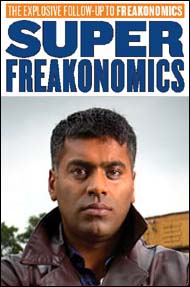
In the first installment of our virtual book club, Emily Oster answered your questions about her research (co-authored with Rob Jensen) which argues that the lives of rural women in India improved on several dimensions thanks to the widespread adoption of television.
That story appeared in our book’s introduction. Now we’re moving on to Chapter One.
We will probably feature a few Q&A’s with the subjects and researchers featured in this chapter, which is described in the Table of Contents like this:
1. How is a street prostitute like a department-store Santa?
In which we explore the various costs of being a woman.
Meet LaSheena, a part- time prostitute … One million dead “witches” … The many ways in which females are punished for being born female … Even Radcliffe women pay the price … Title IX creates jobs for women; men take them … 1 of every 50 women a prostitute … The booming sex trade in old-time Chicago … A survey like no other … The erosion of prostitute pay … Why did oral sex get so cheap? … Pimps versus Realtors … Why cops love prostitutes … Where did all the schoolteachers go? … What really accounts for the male-female wage gap? … Do men love money the way women love kids? … Can a sex change boost your salary? … Meet Allie, the happy prostitute; why aren’t there more women like her?
Today we concentrate on “a survey like no other,” and invite you to ask questions of the man behind that survey, Sudhir Venkatesh. He is a sociologist at Columbia University who did his graduate work at the University of Chicago and conducted years’ worth of valuable, fascinating field work there.
One chapter in Freakonomics was based on a series of papers Sudhir wrote with Steve Levitt about the economics of a crack-selling gang. (He did a Q&A on that topic here; and he wrote a book, Gang Leader for a Day, about that research.)
In SuperFreakonomics, we write about the field work that Sudhir conducted with street prostitutes in Chicago. There is a lot to be said about the findings of the research (mostly concerning prices and services) as well as methodology, the historical changes and context of street prostitution, and even how the prostitutes engage in what economists call price discrimination, or charging different prices for the same product.
Sudhir has agreed to field your questions about his research, so leave them in the comments section below. As always, we’ll post the answers shortly. For those of you who haven’t yet read this chapter, here are a few relevant excerpts:
Venkatesh, knowing that traditional survey methods don’t necessarily produce reliable results for a sensitive topic like prostitution, tried something different: real-time, on-the-spot data collection. He hired trackers to stand on street corners or sit in brothels with the prostitutes, directly observing some facets of their transactions and gathering more intimate details from the prostitutes as soon as the customers were gone.
Most of the trackers were former prostitutes — an important credential because such women were more likely to get honest responses. Venkatesh also paid the prostitutes for participating in the study. If they were willing to have sex for money, he reasoned, surely they’d be willing to talk about having sex for money. And they were. Over the course of nearly two years, Venkatesh accumulated data on roughly 160 prostitutes in three separate South Side neighborhoods, logging more than 2,200 sexual transactions.
And:
During Venkatesh’s study, six pimps managed the prostitution in West Pullman, and he got to know each of them. They were all men. In the old days, prostitution rings in even the poorest Chicago neighborhoods were usually run by women. But men, attracted by the high wages, eventually took over — yet another example in the long history of men stepping in to outearn women.
These six pimps ranged in age from their early 30’s to their late 40’s and ‘were doing pretty well,’ Venkatesh says, making roughly $50,000 a year. Some also held legit jobs — car mechanic or store manager — and most owned their homes. None were drug addicts.
One of their most important roles was handling the police. Venkatesh learned that the pimps had a good working relationship with the police, particularly with one officer, named Charles. When he was new on the beat, Charles harassed and arrested the pimps. But this backfired. ‘When you arrest the pimps, there’ll just be fighting to replace them,’ Venkatesh says, ‘and the violence is worse than the prostitution.’
And:
How do the Chicago street prostitutes price-discriminate? As Venkatesh learned, they use different pricing strategies for white and black customers. When dealing with blacks, the prostitutes usually name the price outright to discourage any negotiation. (Venkatesh observed that black customers are more likely than whites to haggle — perhaps, he reasoned, because they’re more familiar with the neighborhood and therefore know the market better.) When doing business with white customers, meanwhile, the prostitute makes the man name a price, hoping for a generous offer. As evidenced by the black-white price differential in the data, this strategy seems to work pretty well.
And:
Of all the tricks turned by the prostitutes he tracked, roughly 3 percent were freebies given to police officers. The data don’t lie: a Chicago street prostitute is more likely to have sex with a cop than to be arrested by one.
source: http://freakonomics.blogs.nytimes.com/2009/11/18/superfreakonomics-book-club-ask-sudhir-venkatesh-about-street-prostitution/?scp=3&sq=child%20sex%20trafficking&st=cse
No comments:
Post a Comment